
Last week witnessed major Ukrainian attacks on the Crimean Peninsula against Russian warships and missiles.
Damage is estimated at billions of dollars. The question that arises is: Is Ukraine ready to try to reclaim Crimea?
The peninsula, which extends into the Black Sea, is internationally recognized as part of Ukraine, but has been under Russian occupation since 2014, amid Moscow’s offensive in eastern Ukraine.
At that time, Kremlin-backed forces seized control of the region and held a referendum (which Ukraine and the West deemed illegal) that led to the annexation. One of the arguments put forward by Russia is that the majority of the population of Crimea is of Russian origin and speaks the Russian language.
Right now, Crimea is a Russian stronghold, so it is important not to be fooled about Ukraine’s true ability to reclaim it.
“The (Ukrainian) strategy has two main goals,” says Oleksandr Musienko of the Kiev Center for Military and Legal Studies.
“Firstly, establishing dominance in the northwestern Black Sea, and secondly, weakening Russia’s logistical opportunities for its defense lines in southern Ukraine, near Mariupol and Tokmak (cities now under Russian control).”
In other words, the operation in Crimea goes hand in hand with the Ukrainian counteroffensive in the south of the country, territory partly under Russian control.
It is important to compare this process with some recent Ukrainian successes in Crimea.
On September 13, long-range cruise missiles, supplied by the United Kingdom and France, hit the Russian fleet hard in the Black Sea, in the port of Sevastopol (the main port in Crimea).
Satellite images at the Sevmurzavod pier show two damaged ships.
Two days later, the British Ministry of Defense reported that the Minsk, a large amphibious assault ship, had been “almost certainly functionally destroyed.”
Alongside it, one of the Russian submarines used to fire cruise missiles at Ukraine “was likely catastrophically damaged.”
Perhaps equally important, the British ministry said, is that the dry docks – used for maintenance of the entire Black Sea Fleet – are likely to remain unused “for several months”.
Last Saturday (9/16), Ukraine revealed more details: Special forces played a crucial role in these operations, using boats and “(unspecified) underwater means” to identify and target Russian ships.
Ukraine also destroyed one of Russia’s newest air defense systems – the S-400, which was 64 kilometers from Yevpatoria.
There was another complex operation in which a group of Ukrainian Neptune-type drones and missiles was used to confuse and destroy key components of Russian air defenses in Crimea.
Last Thursday (9/14), for the second time in less than a month, Ukraine defeated an S-400 surface-to-air missile system on the peninsula.
On August 23, at Olenivka, on the western tip of the Tarkhankut Peninsula, Ukraine was able to target another destroyer and a nearby radar station.
Russia is believed to have up to six S-400 bombers in Crimea. Two of them were destroyed.
In not-so-recent operations, Ukraine destroyed Russian radar sites on offshore gas platforms and, according to Kiev, used naval drones to attack a missile carrier at the entrance to the Sevastopol Bay.
With its air bases, troop bases, training camps and fleet on the Black Sea, Crimea has become a crucial point of contention since the beginning of the Russian invasion in February 2022.
“In Crimea, they (the Russians) still have a large stock of artillery and weapons,” Mosienko says. “This is the main logistical supply line (to Moscow).”
Over the months, operations in Kiev have increased in complexity — from an August 2022 drone strike that destroyed an estimated nine aircraft at Saki Air Base, to the current array of missile and drone strikes.
With more advanced weapons on the way, Mosienko believes Ukraine will be able to increase the sophistication of its operations. The analyst specifically cites the US tactical ballistic missiles that Ukraine is trying to acquire and which, he says, could pose a “serious problem for the Russian air defense system.”
Is it possible to restore Crimea? Does all this mean that Kiev is closer to regaining Crimea?
“It’s closer, but there’s still a lot to do,” says Andriy Ryzhenko, a retired captain in the Ukrainian Navy.
“We need to liberate the coast of the Sea of Azov (on the eastern coast of Crimea) and cut off the land corridor,” he adds, referring to the slow and exhausting Ukrainian counter-offensive underway in the south of the country.
In this discussion, the main point is the Kerch Bridge, which connects Crimea to Russia.
Ukraine has been targeting Moscow’s supply routes in Crimea for nearly a year, but heavy equipment is still unable to traverse this vital route. In July, the bridge was damaged in an attack blamed on Ukraine.
The road is better defended today, but remains within sight of Kiev.
“When we close this bridge in Crimea, we will create a logistical problem for them (Russia),” Ryzhenko says.
Cutting this supply line to Crimea would be disastrous for Moscow and would facilitate a Ukrainian offensive in the south of the country.
But observers in Kiev urge caution.
I think this may be preparation for the liberation of Crimea. “But I think it will take some time,” Mosienko points out. “What we are doing at the moment is paving the way to Crimea.”
The Secretary of the Security and Defense Council of Ukraine, Oleksiy Danilov, said on Saturday (16/9) that Ukraine is using all available means to force Russia to give up Crimea.
“It seems that if the Russians do not want to leave Crimea of their own free will, we will have to expel them,” he said in an interview.

“Proud explorer. Freelance social media expert. Problem solver. Gamer.”

:strip_icc()/i.s3.glbimg.com/v1/AUTH_59edd422c0c84a879bd37670ae4f538a/internal_photos/bs/2024/X/z/pYwEeeTnSBjUJdJIX0Fw/piramides-egito.png)




